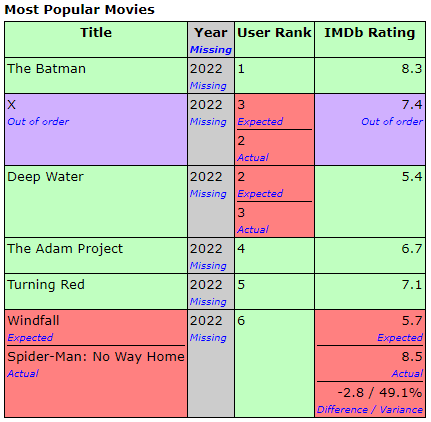Tablasco is a baseline testing utility for JUnit. It was initially developed to verify financial reports but can be used to make assertions on any outputs that can be presented in a tabular format.
Tablasco's table verification algorithm can process tens of thousands of table rows out-of-the-box, and many more with custom configuration. Verification can be configured to control behavior such as verifying row order, ignoring headers and applying tolerance to floating-point values.
Each test produces a color-coded HTML report showing how the actual and expected tables differed helping developers quickly identify problems. Output can be configured to support large datasets by hiding matched rows and collapsing similar breaks.
Each Tablasco test is backed by a text file containing expected results; this baseline file is normally saved with the code in version control. If a test fails because of a change that caused an expected difference the test can be rebased to update the text file with the new results.
The two most important Tablasco classes to be familiar with are TableVerifier and VerifiableTable.
TableVerifier is a JUnit rule that needs to be defined in
each Tablasco test class:
@Rule
public final TableVerifier tableVerifier = new TableVerifier()
.withExpectedDir("src/test/resources")
.withOutputDir("target");
JUnit, by design, ensures that each test method has its own instance of TableVerifier and Tablasco takes advantage of
this to offer a fluent API that allows configuration to cascade from the project, to the class, to the test level. To
set project level configuration you can wrap the initialisation code above in a factory method:
@Rule
public final TableVerifier tableVerifier =
MyTableVerifierFactory.newTableVerifier();
Configuration that you want to apply at a class level can be set when the field is initialised:
@Rule
public final TableVerifier tableVerifier =
MyTableVerifierFactory.newTableVerifier().withHideMatchedRows(true);
And finally, configuration required at the test level can be applied inline:
@Test
public void myTest()
{
this.tableVerifier.withTolerance(0.1d).verify(tables);
}
The VerifiableTable
interface is an abstract definition of a table that Tablasco understands. Tests need to adapt the data they are verifying
to an instance of VerifiableTable. These adapters are typically shared across tests or even across applications.
TableVerifier compares instances of VerifiableTable with the baseline results file; if the tables match the test
passes, otherwise the test fails.
@Test
public void tableToBaselineTest()
{
VerifiableTable table = new MyResultsVerifiableTable(getResults());
this.tableVerifier.verify("results", table);
}
To rebase a test or suite of tests set the system property rebase=true or configure the verifier directly using
.withRebase(). As a precaution to prevent developers accidentally leaving rebase switched on, rebasing tests always
fail.
